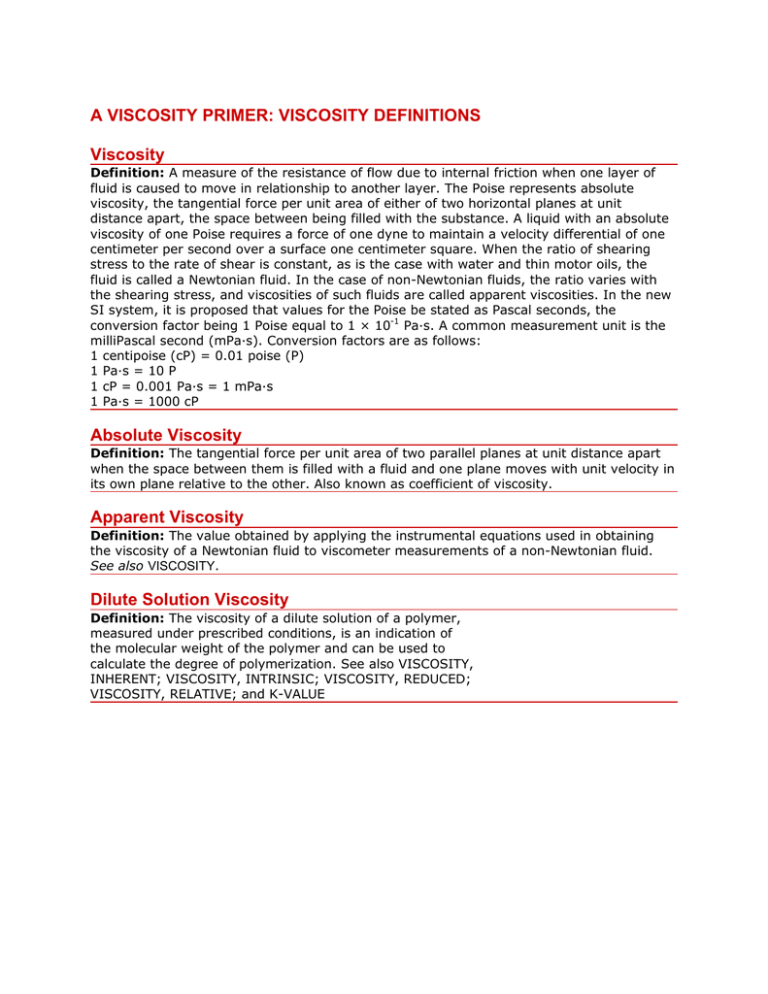A VISCOSITY PRIMER: VISCOSITY DEFINITIONS Viscosity
advertisement

A VISCOSITY PRIMER: VISCOSITY DEFINITIONS Viscosity Definition: A measure of the resistance of flow due to internal friction when one layer of fluid is caused to move in relationship to another layer. The Poise represents absolute viscosity, the tangential force per unit area of either of two horizontal planes at unit distance apart, the space between being filled with the substance. A liquid with an absolute viscosity of one Poise requires a force of one dyne to maintain a velocity differential of one centimeter per second over a surface one centimeter square. When the ratio of shearing stress to the rate of shear is constant, as is the case with water and thin motor oils, the fluid is called a Newtonian fluid. In the case of non-Newtonian fluids, the ratio varies with the shearing stress, and viscosities of such fluids are called apparent viscosities. In the new SI system, it is proposed that values for the Poise be stated as Pascal seconds, the conversion factor being 1 Poise equal to 1 × 10-1 Pa·s. A common measurement unit is the milliPascal second (mPa·s). Conversion factors are as follows: 1 centipoise (cP) = 0.01 poise (P) 1 Pa·s = 10 P 1 cP = 0.001 Pa·s = 1 mPa·s 1 Pa·s = 1000 cP Absolute Viscosity Definition: The tangential force per unit area of two parallel planes at unit distance apart when the space between them is filled with a fluid and one plane moves with unit velocity in its own plane relative to the other. Also known as coefficient of viscosity. Apparent Viscosity Definition: The value obtained by applying the instrumental equations used in obtaining the viscosity of a Newtonian fluid to viscometer measurements of a non-Newtonian fluid. See also VISCOSITY. Dilute Solution Viscosity Definition: The viscosity of a dilute solution of a polymer, measured under prescribed conditions, is an indication of the molecular weight of the polymer and can be used to calculate the degree of polymerization. See also VISCOSITY, INHERENT; VISCOSITY, INTRINSIC; VISCOSITY, REDUCED; VISCOSITY, RELATIVE; and K-VALUE K-Value Definition: (1) A number calculated from dilute solution viscosity measurements of a polymer; sometimes used to indicate likely degree of polymerization/molecular size. The formula is: Where: NS = viscosity of solution N0 = viscosity of solvent c = concentration in grams/mL Kinematic Viscosity Definition: The absolute viscosity of a fluid divided by the density of the fluid. Also known as the coefficient of kinematic viscosity. Measured in stokes (St) or centistokes (cSt). One centistoke = 0.01 stokes. The metric unit is square metres per second (m2/s). A common metric measurement unit in glass capillary viscometry is millimeters squared per second (mm2/s). Conversion factors are as follows: 1 St = 1 x 10-4m2/s 1 m2/s = 10,000 St 1 cSt = 1 x 10-6m2/s = 1 mm2/s 1 m2/s = 1,000,000 cSt Centistokes may be converted to centipoise (cP) by multiplying by the density of the fluid being measured, all measured at the same temperature Intrinsic Viscosity ([η]) Definition: The ratio of a solution’s specific viscosity to the concentration of the solute, extrapolated to zero concentration. Intrinsic viscosity reflects the capability of a polymer in solution to enhance the viscosity of the solution. The viscosity behavior of macromolecular substances in solution is one of the most frequently used approaches for characterization. The intrinsic viscosity number is defined as the limiting value of the specific viscosity/concentration ratio at zero concentration. Intrinsic viscosity is determined by measuring the relative viscosity at several different concentrations and then extrapolating the specific viscosity to zero concentration. The variation of the viscosity number with concentration depends on the type of molecule as well as the solvent. In general, the intrinsic viscosity of linear macromolecular substances is related to the molecular weight or degree of polymerization. With linear macromolecules, viscosity number measurements can provide a method for the rapid determination of molecular weight when the relationship between viscosity and molecular weight has been established. Intrinsic viscosity is calculated by determining the reduced viscosity (ηsp/c) and extrapolating to infinite dilution. Huggins equation [η ] = limη red c → 0 Craemer equation [η ] = limη inh c → 0 Where: c = concentration of polymer in grams per 100 milliliters of solution Also known as LIMITING VISCOSITY NUMBER. Inherent Viscosity (ηinh) Definition: The quotient of the natural logarithm of relative viscosity and the concentration. Inherent viscosity (η inh) is expressed in the following equation: ln η rel c Where: c = concentration η rel = relative viscosity (unitless ratio) η inh = Reduced Viscosity (ηred) Definition: The specific viscosity (ηsp) divided by the concentration, expressed in g/ml. Also known as VISCOSITY NUMBER. Reduced viscosity (η red ) is expressed in the following equation: η red = η rel − 1 c Where: c = concentration η rel = relative viscosity (unitless ratio) Relative Viscosity (ηrel) Definition: The ratio of the viscosities of the polymer solution (of stated concentration) and of the pure solvent at the same temperature. Also known as SOLUTION SOLVENT VISCOSITY RATIO. Relative viscosity (ηrel) is expressed in the following equation: ρ1 (C1t1 - E1/t 12 ) nrel = ρ 0 (C0 t 0 - E 0 /t 0 2 ) Where: ρ = density C = tube calibration constant (cSt/s) E = kinetic energy correction constant (cSt·s2) t = flow time (seconds) Specific Viscosity (ηsp) Definition: The relative viscosity of a polymer solution of known concentration minus 1; usually determined at low concentration of the polymer; for example, 0.5 gram per 100 milliliters of solution, or less.




